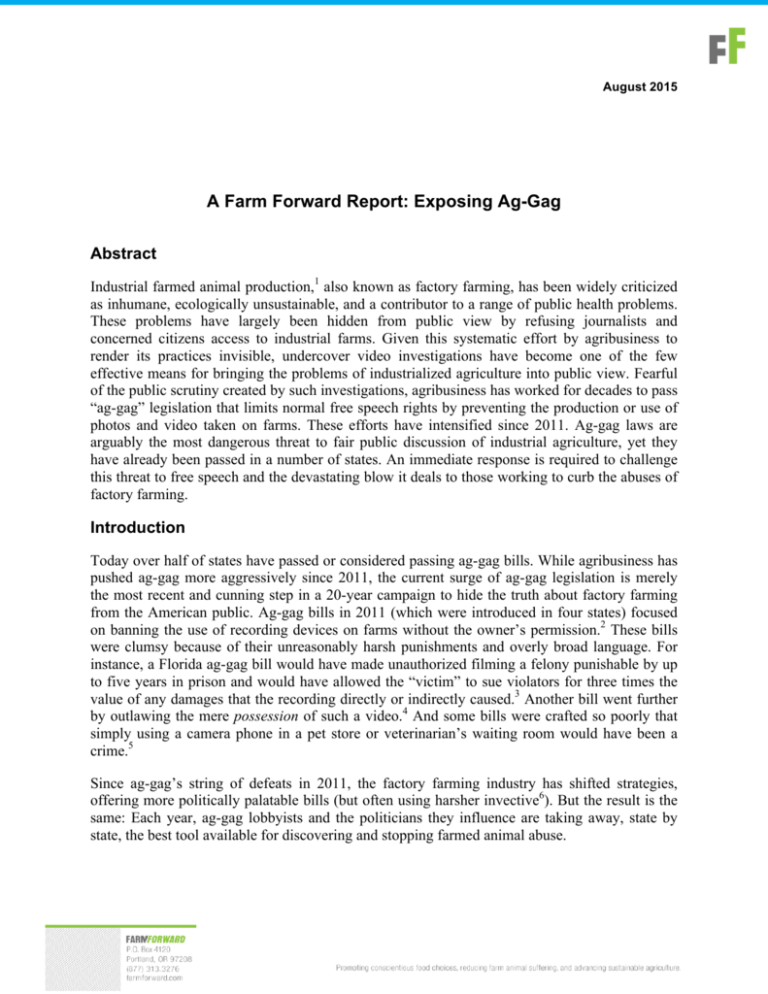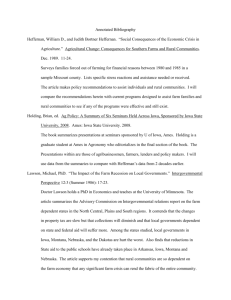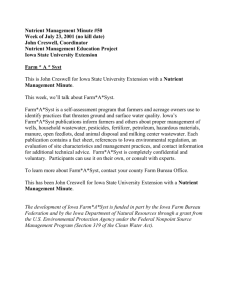Read the full white paper
advertisement

August 2015 A Farm Forward Report: Exposing Ag-Gag Abstract Industrial farmed animal production,1 also known as factory farming, has been widely criticized as inhumane, ecologically unsustainable, and a contributor to a range of public health problems. These problems have largely been hidden from public view by refusing journalists and concerned citizens access to industrial farms. Given this systematic effort by agribusiness to render its practices invisible, undercover video investigations have become one of the few effective means for bringing the problems of industrialized agriculture into public view. Fearful of the public scrutiny created by such investigations, agribusiness has worked for decades to pass “ag-gag” legislation that limits normal free speech rights by preventing the production or use of photos and video taken on farms. These efforts have intensified since 2011. Ag-gag laws are arguably the most dangerous threat to fair public discussion of industrial agriculture, yet they have already been passed in a number of states. An immediate response is required to challenge this threat to free speech and the devastating blow it deals to those working to curb the abuses of factory farming. Introduction Today over half of states have passed or considered passing ag-gag bills. While agribusiness has pushed ag-gag more aggressively since 2011, the current surge of ag-gag legislation is merely the most recent and cunning step in a 20-year campaign to hide the truth about factory farming from the American public. Ag-gag bills in 2011 (which were introduced in four states) focused on banning the use of recording devices on farms without the owner’s permission.2 These bills were clumsy because of their unreasonably harsh punishments and overly broad language. For instance, a Florida ag-gag bill would have made unauthorized filming a felony punishable by up to five years in prison and would have allowed the “victim” to sue violators for three times the value of any damages that the recording directly or indirectly caused.3 Another bill went further by outlawing the mere possession of such a video.4 And some bills were crafted so poorly that simply using a camera phone in a pet store or veterinarian’s waiting room would have been a crime.5 Since ag-gag’s string of defeats in 2011, the factory farming industry has shifted strategies, offering more politically palatable bills (but often using harsher invective6). But the result is the same: Each year, ag-gag lobbyists and the politicians they influence are taking away, state by state, the best tool available for discovering and stopping farmed animal abuse. Why Undercover Video is Necessary In recent years, undercover video of animal abuse on factory farms has become a crucial instrument of animal protection groups like the Humane Society of the United States (HSUS) and Mercy For Animals. Proponents of ag-gag have attempted to characterize undercover videos as publicity stunts meant to unfairly disparage the meat industry.7 It is clear, however, that investigations have played an important and helpful role in holding industry accountable for both animal abuse and public health violations. In 2008, a meat packager in California known as the Westland/Hallmark Meat Packing Company (WLHM) shocked the nation when it issued the largest meat recall in US history.8 The 143million-pound beef recall—equivalent to two quarter-pound hamburgers for each man, woman, and child in the US—quadrupled the previous US record. The recall was initiated in response to allegations that “downer cattle” (those unable to walk to slaughter) were being processed for human consumption.9 Downer cattle, which the USDA has called “unfit for human food,”10 are banned from slaughter because they pose a heightened risk of E. Coli, bovine spongiform encephalopathy (mad cow disease), and salmonella.11 Since the recall included beef products going back as far as two years, most of the meat had already been eaten, including 37 million pounds12 that WLHM had provided to the federal School Lunch Program.13 The only thing more shocking than the recall itself is the reason it was initiated. Though the USDA stated that inspectors were present “continuously,”14 and though the plant passed no less than 17 separate food safety and humane handling audits in 2007,15 it took an undercover video filmed by HSUS to prompt the recall. In late 2007, while USDA inspectors and independent food auditors “continuously” oversaw WLHM, an HSUS member gained employment at the plant. During the six weeks he worked there, he shot video showing other plant employees using forklifts and electric prods to force downer cattle to slaughter.16 Some employees kicked the sick animals, and at one point an employee tried to force water up the nose of a downer cow, a method that Michigan Congressman Bart Stupak referred to as “waterboarding.”17 After these images were captured, the HSUS contacted local prosecutors but was asked to withhold the tapes pending an investigation. After waiting over two months, the HSUS was so frustrated at the pace of the investigation that it released the video.18 Two days later, the plant voluntarily suspended operations; three days later, the USDA suspended the plant, and less than two weeks after that the largest meat recall in US history was announced.19 Two of the employees shown in the video were fired and subsequently brought up on felony and misdemeanor animal abuse charges.20 The US Department of Justice would eventually file complaints against the plant for accepting millions of dollars in federal contracts while lying about one of its partners’ felony convictions and illegally slaughtering downer cows for upwards of four years.21 Despite multiple layers of federal supervision, scores of independent audits, and a questionable track record (WLHM was temporarily shut down in 1993 when a related E. Coli outbreak killed three children22), it was the release of an undercover video that prompted action. Exposing Ag-Gag: A Farm Forward Report 2 The Food Safety Inspection Service (FSIS), the branch of the USDA that oversees slaughterhouses like WLHM, conducted an investigation after the recall and found that “there is an inherent vulnerability that humane handling violations can occur and not be detected by FSIS inspectors because FSIS does not provide continuous surveillance of all operating areas within a slaughter establishment at all times.”23 Finding “deliberate actions by Hallmark personnel to bypass required inspections, as well as noncompliance with required inspection procedures by FSIS in-plant staff,” the investigators recommended determining “whether FSIS-controlled inplant video monitoring would be beneficial in preventing and detecting animal abuses.”24 Incredibly, the USDA dismissed this recommendation. Asserting that video cameras would not be helpful, USDA’s management instead promised to issue non-binding guidance on how slaughterhouses can use cameras for internal purposes if they so choose.25 Thus, a federal investigation initiated because of humane handling violations revealed by undercover video surveillance concluded that video surveillance “would not provide the definitive data needed to support enforcement of humane handling requirements.”26 It is worth revisiting the 17 independent audits that WLHM passed in 2007 and considering the details. At least two of them occurred during or very shortly after the HSUS footage was captured.27 One of these audits concluded that WLHM has “a sound food safety system that goes above and beyond that which would normally be expected or required from a regulatory standpoint. The company management is rightfully proud of their food safety system.”28 Another audit issued around the same time gave WLHM a perfect rating in both the Livestock Condition and Humane Handling categories, including a perfect score for not “dragging a conscious, nonambulatory animal” and not “hitting or beating an animal”—two activities that are clearly documented by the HSUS video, and which the audit report itself states are considered “grounds for automatic audit failure.”29 A third auditor, writing on the same date that WLHM suspended operations (Feb 1, 2008), stated that “I have reviewed the records and programs you have at your plant [which] are the best I have ever seen in any plant…. Your plant has passed numerous audits on humane handling of animals in this plant in the year of 2007 and has no failures, which you should to [sic] be very proud of.” In making these statements, the auditor relied on his “substantial experience” of over 25 years with the FSIS.30 If neither government nor third-party oversight could catch such egregious violations (the video footage made even WLHM’s CEO declare, “I was shocked. I was horrified. I was sickened.”31), what can? Courageous individuals must expose abuse or there will be no reform; as 30-yearveteran food safety consultant Robert A. LaBudde put it, “The only thing that matters is productivity…you only get in trouble if someone in the media traces it back to you, and that’s rare, like a meteor strike.”32 Legislative Efforts to Ban Farm Video When it became known in 2011 that, in addition to the four states where ag-gag bills had been introduced, another four states were considering introducing similar or identical bills, many animal welfare advocates began seeing ag-gag less as an interesting anomaly and more as an alarming trend.33 This trend—which some did not originally consider threatening because ag-gag likely violates constitutionally protected free speech34—began over 20 years ago, when ag-gag Exposing Ag-Gag: A Farm Forward Report 3 lobbyists found success in Montana,35 Kansas,36 and especially North Dakota.37 Buried in North Dakota’s criminal code is a provision stating that “No person without the effective consent of the owner may: (6) Enter an animal facility and use or attempt to use a camera, video recorder, or any other video or audio recording equipment.”38 Violators can be jailed for 30 days, fined $1000, and sued for three times the amount of actual and consequential damages.39 The fact that such a law was passed—and, what is more, had never been successfully challenged—intimated that the bills introduced in 2011 might pass political and constitutional muster. Fortunately, the ag-gag legislation introduced in 2011 ultimately failed because it was too vague and draconian. However, ag-gag’s legislative sponsors learned from their mistakes, redoubled their efforts, and vowed to pass ag-gag in 2012.40 More than twice as many states introduced ag-gag bills in 2012 as did in 2011,41 and three states passed such bills. On March 2, 2012, Iowa’s governor signed an ag-gag bill into law.42 The newly enacted measure, which took effect without prior notice because it was “deemed of immediate importance,” creates the crime of “agricultural production facility fraud,” defined broadly to include obtaining access to or employment at an agricultural facility under false pretenses, a basic technique of investigative journalism.43 Violators face up to two years in prison and anyone who fails to report a known violation could face criminal prosecution as well.44 On March 20, Utah followed Iowa’s lead and outlawed undercover videos, with penalties as severe as one year in jail.45 Finally, on May 17, Missouri passed what appeared to be a compromise on ag-gag: While the full ag-gag bill was rejected, new laws were passed that stiffen the penalties for trespassing and require anyone with video evidence of farmed animal abuse to turn it over to the police within 24 hours.46 Yet rather than protect animals, this “quickreporting” bill is just another (in some ways more insidious) version of ag-gag, since undercover investigations typically require months, not hours, to document enough abuse to successfully pressure law enforcement to make arrests and persuade major media outlets to pay attention. Given its three successes in 2012, in 2013 agribusiness again redoubled its efforts. The onslaught of new ag-gag bills prompted some to ask whether 2013 would be the “Year of Ag Gag.”47 Fights raged throughout the legislative session in 11 states,48 but in the end every single ag-gag bill (15 in all) was defeated.49 In February, Amy Meyer became the first person to be prosecuted under an ag-gag provision50 when she was charged with violating Utah’s 2012 ag-gag law.51 Meyer, a self-described animal activist, had the audacity to film a slaughterhouse in Draper, Utah from a public roadway52—a slaughterhouse partially owned by Draper’s mayor. Charges were only dropped after environmental reporter Will Potter broke the story of her prosecution and caused a national uproar.53 While Meyer ultimately did not pay any fines or serve any jail time, the incident serves as a sad example of how these laws, already broadly written, can be even more broadly enforced (i.e., mis-enforced) against those wishing to exercise their First Amendment rights and expose the cruelty that is endemic to factory farming. When an industry is so corrupt, sloppy, and cruel that it cannot stand up under serious scrutiny, its last resort is to attack the ones doing the scrutinizing. Despite the public backlash to ag-gag that the Meyer case incited, 10 states introduced ag-gag legislation in 2014,54 and Idaho became the seventh state to make ag-gag law when it criminalized undercover video recording in an agricultural operation, imposing up to a year of Exposing Ag-Gag: A Farm Forward Report 4 jail time and fines as high as $5000.55 In response, Farm Forward joined a coalition of public interest organizations to sue Idaho in federal court and strike down its ag-gag law as unconstitutional. On August 3, 2015, U.S. District Court Chief Judge B. Lynn Winmill struck down the law for violating the First Amendment right to free speech and the Fourteenth Amendment’s Equal Protection Clause.56 Several states have already introduced ag-gag bills in 2015, and in June North Carolina legislators overrode their governor’s veto and became the eighth state to pass ag-gag.57 Previous forms of ag-gag criminalized undercover video, made it illegal to gain employment under false pretenses (e.g., by lying about being an undercover investigator), or imposed quick reporting requirements (which preclude investigators from amassing evidence over time); many of them also granted operations the right to sue investigators for damages resulting from their now-illegal conduct. While North Carolina’s ag-gag law does not impose criminal sanctions, it does grant the right to sue employees for any damages occurring as a result of exposing abuse, including punitive damages of up to $5000 per day.58 In overriding the governor’s veto, legislators also overrode public outcry from groups as diverse as the Wounded Warrior Project and the AARP, which argued that the law was broad enough to make whistleblowing at hospitals, nursing homes, and daycare centers actionable.59 But agribusiness wields tremendous power in North Carolina and, as one local farmer put it, “It was between people and money, and money won.”60 Indeed, supporters of ag-gag legislation often claim that such measures are necessary to protect agribusiness interests; they show little concern for the free speech rights of citizens. In Iowa, for instance, State Sen. John P. Kibbie said that the 2011 bill was needed because it would “make producers feel more comfortable.”61 The Iowa Poultry Association, which helped write that bill,62 made the bizarre suggestion that ag-gag legislation is needed because animal welfare advocates might sneak onto farms in order to make fake videos, though its chief executive could not name a single instance of something like that happening.63 Some arguments are even stranger. The Iowa Cattlemen’s Association made the almost incomprehensible claim that the bill would prevent animal cruelty (it argued that activists who record abuse but don’t report it immediately are themselves guilty of abuse).64 In Minnesota, State Sen. Doug Magnus said his 2011 bill was “aimed at people who are harassing and sabotaging operations,” again failing to note that such “sabotage” is already a serious crime and thus could not be the real motivation behind the legislation.65 Taking Action Mere hours after the 2011 Florida bill was defeated, its sponsoring senator expressed confidence that the bill would pass the next time it was introduced.66 His prediction didn’t come true. With the vocal support of voters who rightly saw the bill as an assault on free speech, fair labor practices, food safety, and animal welfare, the Florida legislature killed the bill in late January 2012.67 To stem the tide of ag-gag, we must emulate the breadth and tenacity of that opposition in every state. The first and most important step is to make our voices heard by standing up for our right to know about the safety and humaneness of our food supply. If those filming these videos are the eyes and ears of the public, we are its mouth! We have the power to bring this issue to the attention of our family, friends, and coworkers. We have the power to write our Exposing Ag-Gag: A Farm Forward Report 5 legislators and tell them to not even consider passing video bans. We have the power to stay informed about this and other animal welfare abuses. To learn simple steps for how to fight ag-gag where you live, go to ag-gag.org. Report by Farm Forward Policy & Program Director Michael McFadden, Esq. 1 See “Putting Food on the Table: Industrial Farm Animal Production in America,” Pew Commission on Industrial Farm Animal Production, available at http://www.ncifap.org/_images/PCIFAPFin.pdf. 2 Bob Van Sternberg, “Bill would ban video of farming operations,” Star Tribune, April 5, 2011, available at http://www.startribune.com/politics/statelocal/119516799.html. See also Mark Bittman, “Some Animals Are More Equal Than Others,” The New York Times, March 15, 2011, available at http://opinionator.blogs.nytimes.com/2011/03/15/some-animals-are-more-equal-than-others/. 3 Iowa Senate File 431 – Introduced, available at http://coolice.legis.state.ia.us/CoolICE/default.asp?Category=BillInfo&Service=Billbook&menu=text&ga=84&hbill=SF431. 4 See, e.g., Minnesota House File 1369, available at https://www.revisor.mn.gov/revisor/pages/search_status/status_detail.php?b=House&f=HF1369&ssn=0&y=2011. 5 Ibid. 6 For example, the term “industrial terrorism” was used in reference to undercover investigations this year. See Stephanie Armour, “‘Industrial Terrorism’ of Undercover Livestock Videos Targeted,” Bloomberg, February 21, 2012, available at http://www.businessweek.com/news/2012-02-21/-industrial-terrorism-of-undercover-livestockvideos-targeted.html. 7 For example, Iowa Representative Dan Muhlbauer, D-Manilla, himself a hog and cattle producer, said of a 2008 PETA undercover video that “They were more interested in getting the publicity than in the welfare of the animals.” Rod Swoboda, “Farmers Say Video-Ban Law is Needed,” Wallaces Farmer, March 21, 2011, available at http://wallacesfarmer.com/story.aspx/farmers/say/videoban/law/is/needed/9/47671. Elsewhere, Iowa State Sen. Tom Reilly, D-Oskaloosa, stated that “They want to hurt an important part of our economy…. These people don’t want us to have eggs; they don’t want people to eat meat.” Mike Wiser, “Iowa may be first to ban secret video on farms,” Sioux City Journal, May 22, 2011, available at http://www.siouxcityjournal.com/news/state-andregional/iowa/article_7710d785-77b4-5183-9b05-edd788c9e33b.html. 8 Andrew Martin, “Largest Recall of Ground Beef is Ordered,” The New York Times, February 18, 2008, available at http://www.nytimes.com/2008/02/18/business/18recall.html?adxnnl=1&adxnnlx=130340463453bv9+eAwR0szsFZUDf0zA. 9 Ibid. 10 Ibid. In response to the Westland/Hallmark debacle, then-Secretary of Agriculture Ed Schafer stated that “Because the cattle did not receive complete and proper inspection, F.S.I.S. [an arm of the USDA] has determined them to be unfit for human food and the company is conducting a recall.” 11 James R. Healey and Julie Schmit, “USDA orders largest beef recall: 143.3 million pounds,” USA Today, February 18, 2008, available at http://www.usatoday.com/money/industries/food/2008-02-17-slaughterhouserecall_N.htm. 12 It was later revealed that Hallmark had actually supplied closer to 50 million pounds to the school lunch program, not 37 million. Matthew L. Wald, “Meat Packer Admits Slaughter of Sick Cows,” The New York Times, March 13, 2008, available at http://www.nytimes.com/2008/03/13/business/13meat.html. 13 See Note 8, supra. 14 Ibid. 15 Michael Moss and Andrew Martin, “Food Problems Elude Private Investigators,” The New York Times, March 9, 2009, available at http://www.nytimes.com/2009/03/06/business/06food.html. 16 Gillian Flaccus, “Suit: Meatpacker used ‘downer’ cows for 4 years,” Associated Press, September 24, 2009, available at http://seattletimes.nwsource.com/html/nationworld/2009936730_apusslaughterhouseabuse.html. Exposing Ag-Gag: A Farm Forward Report 6 17 See Note 12, supra. Andrew Martin, “Humane Society Criticized in Meat Quality Scandal,” The New York Times, February 27, 2008, available at http://www.nytimes.com/2008/02/27/business/27food.html?ref=westlandhallmarkmeatcompany. 19 “Evaluation of FSIS Management Controls Over Pre-Slaughter Activities (Audit Report 24601-7-KC),” November 2008, available at http://www.usda.gov/oig/webdocs/24601-07-KC.pdf. i. 20 See Note 8, supra. 21 See Note 16, supra. 22 See Note 12, supra. 23 See Note 19, supra, at iii (emphasis added). 24 See Note 19, supra, at iii and 16. 25 See Note 19, supra, at 16. 26 See Note 19, supra, at 16. 27 “The Trouble with Food Safety Audits,” The New York Times, available at http://documents.nytimes.com/foodsafety-peanut-inspection#p=41&a=63. 41-61. Hallmark’s president reported that the HSUS employee worked at Hallmark from October 3 to November 14, 2007. Of the 17 independent audits conducted in 2007, one was conducted on November 13 and 14, and another was conducted a week later on November 21. It is possible that other audits were performed during the same period. 28 Ibid.: 46 29 Ibid.: 58 30 Ibid.: 61 31 See Note 12, supra. 32 See Note 15, supra. 33 See Note 2, supra. See also April 14, 2011 email from Kathleen Masterson (on file) stating that several Iowa state senators reported being approached by legislators from Nebraska, Idaho, Indiana and Missouri who were considering introducing legislation similar to the proposed Iowa ban. 34 See, e.g., Carolyn E. Wright, “Are the Proposed Bills to Prevent Photos of Farms Legal,” March 11, 2011, available at http://www.photoattorney.com/?p=2064; Mike Wiser, “Iowa may be first to ban secret video on farms,” supra at Note 7. 35 Farm Animal and Research Facility Protection Act, MT ST 81-30-101-105, 1991 available at http://www.animallaw.info/statutes/stusmtst81_30_101.htm#s101 36 The Farm Animal and Field Crop and Research Facilities Protection Act, KS ST 47-1825-1830, 1990, available at http://www.animallaw.info/statutes/stusks47_1825.htm#s1827 37 Animal Research Facility Damage, ND ST 12.1-21.1-01-05, 1991, available at http://www.animallaw.info/statutes/stusndst12_1_21_1_01.htm. 38 Ibid.: § 12.1-21.1-02. Animal facility—Damage or destruction. 39 Ibid.: § 12.1-21.1-05. Civil action. 40 Dave Heller, “Bill to ban undercover video on farms defeated,” Gannett News, May 16, 2011, available at http://www.myfoxtampabay.com/dpp/news/state/bill-to-ban-undercover-video-on-farms-defeated-05162011. 41 Nine states formally considered ag-gag in 2012 (NY, FL, IA, IN, UT, TN, MO, NE, MN); in 2011, only four states did so, while legislators from four others considered doing so but never introduced a bill. 42 Mike Glover, “Branstad signs bill making it a crime to lie to record animal abuse,” The Associated Press, March 2, 2012, available at http://www.desmoinesregister.com/article/20120302/NEWS/303020057/Branstad-signs-billmaking-crime-lie-record-animal-abuse . 43 Iowa House File 589, available at http://coolice.legis.state.ia.us/linc/84/external/govbills/HF589.pdf. 44 Second convictions are considered aggravated misdemeanors with no specified penalty; such crimes are punishable under Iowa’s general criminal code, which provides for up to 2 years’ imprisonment and fines up to $6250. Iowa Corrections Code Chapter 903.1.2, available at http://search.legis.state.ia.us/nxt/gateway.dll/ic?f=templates&fn=default.htm. 45 Dan Flynn, “Five States Now Have ‘Ag-Gag’ Laws on the Books,” Food Safety News, March 26, 2012, available at http://www.foodsafetynews.com/2012/03/five-states-now-have-ag-gag-laws-on-the-books/ 18 Exposing Ag-Gag: A Farm Forward Report 7 46 Dan Flynn, “‘Show Me’ State Compromises on Ag-Gag,” Food Safety News, May 18, 2012, available at http://www.foodsafetynews.com/2012/05/show-me-state-compromises-on-ag-gag/. 47 Suzie Cagle, “Will 2013 be the year of ag-gag bills?,” Grist, January 29, 2013, available at http://grist.org/news/will-2013-be-the-year-of-ag-gag-bills/. 48 Eliza Barclay, “2013 Was The Year Bills To Criminalize Animal Cruelty Videos Failed,” National Public Radio, December 27, 2013, available at http://www.npr.org/sections/thesalt/2013/12/19/255549796/2013-was-the-yearevery-new-ag-gag-bill-failed. The 11 states that proposed ag-gag legislation were Arkansas, California, Indiana, Nebraska, New Hampshire, New Mexico, North Carolina, Pennsylvania, Tennessee, Vermont, and Wyoming. 49 Ibid. 50 Leighton Akio Woodhouse, “Charged With the Crime of Filming a Slaughterhouse,” The Nation, July 31, 2013, available at http://www.thenation.com/article/175506/charged-crime-filming-slaughterhouse. 51 Jim Dalrmple II, “Utah prosecutor dismisses suddenly high-profile ‘ag gag’ case,” The Salt Lake Tribune, May 1, 2013, available at http://www.sltrib.com/sltrib/news/56240592-78/case-meyer-law-gag.html.csp. 52 Ibid. 53 Ibid. 54 Matt Dominguez, “The Animal Agriculture Industry Fails Again Trying to Silence Whistleblowers,” One Green Planet, November 7, 2014, available at http://www.onegreenplanet.org/animalsandnature/the-animal-agricultureindustry-fails-again-trying-to-silence-whistleblowers/. The 10 states that proposed ag-gag legislation were Arizona, Colorado, Idaho, Indiana, Kentucky, New Hampshire, North Carolina, Pennsylvania, Tennessee, and Vermont. 55 Cindy Galli, “Turn Off That Camera! Idaho Gov Signs Touch ‘Ag-Gag’ into Law,” ABC News, February 28, 2014, available at http://abcnews.go.com/Blotter/turn-off-camera-idaho-gov-signs-tough-ag/story?id=22726424. 56 Luke Runyon, “Judge Strikes Down Idaho ‘Ag-Gag’ Law, Raising Questions For Other States,” National Public Radio, August 4, 2015, available at http://www.npr.org/sections/thesalt/2015/08/04/429345939/idaho-strikes-downag-gag-law-raising-questions-for-other-states. 57 Lindsay Abrams, “North Carolina’s chilling new twist on ‘ag-gag,’” Salon, June 4, 2015, available at http://www.salon.com/2015/06/04/north_carolinas_chilling_new_twist_on_ag_gag/. Note that only seven states now have ag-gag laws in the wake of the Idaho ag-gag law’s being struck down. 58 Ibid. 59 Ibid. 60 Ibid. 61 See A. G. Sulzberger, “States Look to Ban Efforts to Reveal Farm Abuse,” The New York Times, April 13, 2011, available at http://www.nytimes.com/2011/04/14/us/14video.html. 62 Ibid. 63 Ibid. 64 Andrew Duffelmeyer, “Ag industry, lawmakers try to limit secret videos,” The Associated Press, March 14, 2011, available at http://www.businessweek.com/ap/financialnews/D9LURVNG0.htm (quoting Association lobbyist Tom Shipley). 65 “Bill would ban video of Minn. farming operations,” The Associated Press, April 12, 2011, available at http://minnesota.publicradio.org/display/web/2011/04/12/farm-videos/. 66 See Note 40, supra. 67 See Note 6, supra. Exposing Ag-Gag: A Farm Forward Report 8






